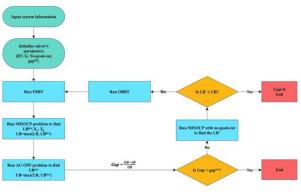A global optimization framework for joint generation and transmission expansion planning with AC power flow representation
IF 5.9
Q2 ENERGY & FUELS
引用次数: 0
Abstract
The integration of renewable energy generating units, often located in remote regions with limited grid connectivity, has created a pressing need for coordinated generation and transmission expansion planning (G&TEP). However, considering full AC network representation, the co-optimization of generation and transmission poses a challenging nonconvex mixed-integer problem that is prone to locally suboptimal solutions. In this study, we propose a tailored global optimization framework to identify the most cost-effective set of generating units and candidate transmission lines while satisfying operational and investment constraints. The proposed solver employs second-order cone relaxation, further enhanced through a set of relaxation-tightening constraints, along with feasibility-based and optimization-based bound tightening techniques to improve relaxation strength. A salient feature of the solver is the integration of a no-good cut technique, which enables efficient exploration of alternative candidate solutions within the feasible region. As demonstrated by numerical results, this technique is specifically tailored to the G&TEP problem and significantly improves solution quality while reducing the runtime required to achieve global optimality. A comparative performance analysis with state-of-the-art global MINLP solvers demonstrates that the proposed approach achieves tighter optimality gaps faster and exhibits superior flexibility and scalability.

基于交流潮流表示的联产扩电规划全局优化框架
可再生能源发电机组通常位于电网连接有限的偏远地区,因此对协调发电和输电扩展规划(G&;TEP)产生了迫切的需求。然而,考虑到全交流网络表示,发电和输电的协同优化是一个具有挑战性的非凸混合整数问题,容易出现局部次优解。在本研究中,我们提出了一个量身定制的全局优化框架,以确定最具成本效益的发电机组和候选输电线路,同时满足运营和投资约束。所提出的求解器采用二阶锥松弛,通过一组松弛收紧约束进一步增强,以及基于可行性和基于优化的约束收紧技术来提高松弛强度。该求解器的一个显著特点是集成了无优切割技术,可以在可行区域内有效地探索备选备选解。数值结果表明,该技术专门针对G&;TEP问题,并显著提高了解决方案的质量,同时减少了实现全局最优所需的运行时间。与最先进的全球MINLP求解器的性能比较分析表明,所提出的方法可以更快地实现更紧凑的最优性差距,并具有卓越的灵活性和可扩展性。
本文章由计算机程序翻译,如有差异,请以英文原文为准。
求助全文
约1分钟内获得全文
求助全文
来源期刊

Renewable Energy Focus
Renewable Energy, Sustainability and the Environment
CiteScore
7.10
自引率
8.30%
发文量
0
审稿时长
48 days
 求助内容:
求助内容: 应助结果提醒方式:
应助结果提醒方式:


